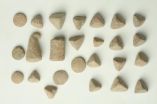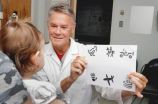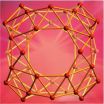(Press-News.org) An archaeological dig in southeast Turkey has uncovered a large number of clay tokens that were used as records of trade until the advent of writing, or so it had been believed.
But the new find of tokens dates from a time when writing was commonplace – thousands of years after it was previously assumed this technology had become obsolete. Researchers compare it to the continued use of pens in the age of the word processor.
The tokens – small clay pieces in a range of simple shapes – are thought to have been used as a rudimentary bookkeeping system in prehistoric times.
One theory is that different types of tokens represented units of various commodities such as livestock and grain. These would be exchanged and later sealed in more clay as a permanent record of the trade – essentially, the world's first contract.
The system was used in the period leading up to around 3000 BC, at which point clay tablets filled with pictorial symbols drawn using triangular-tipped reeds begin to emerge: the birth of writing, and consequently history.
From this point on in the archaeological record, the tokens dwindle and then disappear, leading to the assumption that writing quickly supplanted the token system.
However, recent excavations at Ziyaret Tepe – the site of the ancient city Tušhan, a provincial capital of the Neo-Assyrian Empire – have unearthed a large quantity of tokens dating to the first millennium BC: two thousand years after 'cuneiform' – the earliest form of writing – emerged on clay tablets.
"Complex writing didn't stop the use of the abacus, just as the digital age hasn't wiped out pencils and pens," said Dr John MacGinnis from Cambridge's MacDonald Institute for Archaeological Research, who led the research.
"In fact, in a literate society there are multiple channels of recording information that can be complementary to each other. In this case both prehistoric clay tokens and cuneiform writing used together."
The tokens were discovered in the main administrative building in Tušhan's lower town, along with many cuneiform clay tablets as well as weights and clay sealings. Over 300 tokens were found in two rooms near the back of the building that MacGinnis describes as having the character of a 'delivery area', perhaps an ancient loading bay.
"We think one of two things happened here. You either have information about livestock coming through here, or flocks of animals themselves. Each farmer or herder would have a bag with tokens to represent their flock," said MacGinnis.
"The information is travelling through these rooms in token form, and ending up inscribed onto cuneiform tablets further down the line."
Archaeologists say that, while cuneiform writing was a more advanced accounting technology, by combining it with the flexibility of the tokens the ancient Assyrians created a record-keeping system of greater sophistication.
"The tokens provided a system of moveable numbers that allowed for stock to be moved and accounts to be modified and updated without committing to writing; a system that doesn't require everyone involved to be literate."
MacGinnis believes that the new evidence points to prehistoric tokens used in conjunction with cuneiform as an empire-wide 'admin' system stretching right across what is now Turkey, Syria and Iraq. In its day, roughly 900 to 600 BC, the Assyrian empire was the largest the world had ever seen.
Types of tokens ranged from basic spheres, discs and triangles to tokens that resemble oxhide and bull heads.
While the majority of the cuneiform tablets found with the tokens deal with grain trades, it's not yet known what the various tokens represent. The team say that some tokens likely stand for grain, as well as different types of livestock (such as goats and cattle), but – as they were in use at the height of the empire – tokens could have been used to represent commodities such as oil, wool and wine.
"One of my dreams is that one day we'll dig up the tablet of an accountant who was making a meticulous inventory of goods and systems, and we will be able to crack the token system's codes," said MacGinnis.
"The inventions of recording systems are milestones in the human journey, and any finds which contribute to the understanding of how they came about makes a basic contribution to mapping the progress of mankind," he said.
INFORMATION: END
Prehistoric 'bookkeeping' continued long after invention of writing
2014-07-14
ELSE PRESS RELEASES FROM THIS DATE:
The Lancet Neurology: Post-concussion 'return to play' decision for footballers should be made solely by doctors, says new editorial
2014-07-14
An editorial published today in The Lancet Neurology calls for sports authorities to take into consideration the long term neurological problems that repeated concussions can cause.
Cerebral concussion is the most common form of sports-related traumatic brain injury (TBI), and the long-term effects of repeated concussions may include dementia, amyotrophic lateral sclerosis, and other neurological disorders, say the journal editors.
However, what is perhaps more concerning, is that even when the symptoms of concussion are delayed, or if they come and go quickly, neurological ...
The Lancet Oncology: Differences in treatment likely to be behind differing survival rates for blood cancers between regions within Europe
2014-07-14
Failure to get the best treatment and variations in the quality of care are the most likely reasons why survival for blood cancer patients still varies widely between regions within Europe, according to the largest population-based study of survival in European adults to date, published in The Lancet Oncology.
"The good news is that 5-year survival for most cancers of the blood has increased over the past 11 years, most likely reflecting the approval of new targeted drugs in the early 2000s such as rituximab for non-Hodgkin lymphoma and imatinib for chronic myeloid leukaemia", ...
MUHC researcher unveils novel treatment for a form of childhood blindness
2014-07-14
This news release is available in French.
Montreal, July 13, 2014 — An international research project, led by the Research Institute of the McGill University Health Centre (RI-MUHC) in Montreal, reports that a new oral medication is showing significant progress in restoring vision to patients with Leber congenital amaurosis (LCA). Until now, this inherited retinal disease that causes visual impairment ranging from reduced vision to complete blindness, has remained untreatable. The study is published today in the scientific journal The Lancet.
"This is the first ...
Australia drying caused by greenhouse gases
2014-07-13
NOAA scientists have developed a new high-resolution climate model that shows southwestern Australia's long-term decline in fall and winter rainfall is caused by increases in manmade greenhouse gas emissions and ozone depletion, according to research published today in Nature Geoscience.
"This new high-resolution climate model is able to simulate regional-scale precipitation with considerably improved accuracy compared to previous generation models," said Tom Delworth, a research scientist at NOAA's Geophysical Fluid Dynamics Laboratory in Princeton, N.J., who helped ...
Deep within spinach leaves, vibrations enhance efficiency of photosynthesis
2014-07-13
ANN ARBOR – Biophysics researchers at the University of Michigan have used short pulses of light to peer into the mechanics of photosynthesis and illuminate the role that molecule vibrations play in the energy conversion process that powers life on our planet.
The findings could potentially help engineers make more efficient solar cells and energy storage systems. They also inject new evidence into an ongoing "quantum biology" debate over exactly how photosynthesis manages to be so efficient.
Through photosynthesis, plants and some bacteria turn sunlight, water and ...
Researchers discover boron 'buckyball'
2014-07-13
PROVIDENCE, R.I. (Brown University) -- The discovery 30 years ago of soccer-ball-shaped carbon molecules called buckyballs helped to spur an explosion of nanotechnology research. Now, there appears to be a new ball on the pitch.
Researchers from Brown University, Shanxi University and Tsinghua University in China have shown that a cluster of 40 boron atoms forms a hollow molecular cage similar to a carbon buckyball. It's the first experimental evidence that a boron cage structure—previously only a matter of speculation—does indeed exist.
"This is the first time that ...
Study finds cause of mysterious food allergy, suggests new treatment strategy
2014-07-13
New research in Nature Genetics identifies a novel genetic and molecular pathway in the esophagus that causes eosinophillic esophagitis (EoE), opening up potential new therapeutic strategies for an enigmatic and hard-to-treat food allergy.
EoE is a chronic inflammatory disorder of the esophagus. The condition is triggered by allergic hypersensitivity to certain foods and an over-accumulation in the esophagus of white blood cells called eosinophils (part of the body's immune system). EoE can cause a variety of gastrointestinal complaints including reflux-like symptoms, ...
Antibody halts cancer-related wasting condition
2014-07-13
BOSTON – New research raises the prospect of more effective treatments for cachexia, a profound wasting of fat and muscle occurring in about half of all cancer patients, raising their risk of death, according to scientists from Dana-Farber Cancer Institute.
Many strategies have been tried to reverse the condition, which may cause such frailty that patients can't endure potentially life-saving treatments, but none have had great success.
Scientists reporting in the July 13 advanced online edition of Nature, led by Bruce Spiegelman, PhD, demonstrated that in mice bearing ...
Stanford researchers invent nanotech microchip to diagnose type-1 diabetes
2014-07-13
An inexpensive, portable, microchip-based test for diagnosing type-1 diabetes could improve patient care worldwide and help researchers better understand the disease, according to the device's inventors at the Stanford University School of Medicine.
Described in a paper to be published online July 13 in Nature Medicine, the test employs nanotechnology to detect type-1 diabetes outside hospital settings. The handheld microchips distinguish between the two main forms of diabetes mellitus, which are both characterized by high blood-sugar levels but have different causes ...
Study of noninvasive retinal imaging device presented at Alzheimer's conference
2014-07-13
LOS ANGELES – A noninvasive optical imaging device developed at Cedars-Sinai can provide early detection of changes that later occur in the brain and are a classic sign of Alzheimer's disease, according to preliminary results from investigators conducting a clinical trial in Australia.
The researchers will present their findings July 15 in an oral presentation at the Alzheimer's Association International Conference 2014 in Copenhagen, Denmark. They also were invited by conference organizers to participate in a "breaking news" news conference beginning at 7:30 a.m. Sunday, ...



